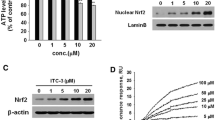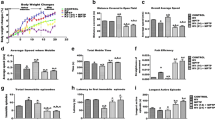Abstract
The etiology of Parkinson’s disease is not completely understood and is believed to be multifactorial. Neuronal disorders associated to oxidative stress and mitochondrial dysfunction are widely considered major consequences. The aim of this study was to investigate the effect of the synthetic arylidenmalonate derivative 5-(3,4-dihydroxybenzylidene)-2,2-dimethyl-1,3-dioxane-4,6-dione (KM-34), in oxidative stress and mitochondrial dysfunction induced by 6-hydroxydopamine (6-OHDA). Pretreatment (2 h) with KM-34 (1 and 10 μM) markedly attenuated 6-OHDA-induced PC12 cell death in a concentration-dependent manner. KM-34 also inhibited H2O2 generation, mitochondrial swelling, and membrane potential dissipation after 6-OHDA-induced mitochondrial damage. In vivo, KM-34 treatment (1 and 2 mg/Kg) reduced percentage of asymmetry (cylinder test) and increased the vertical exploration (open field) with respect to untreated injured animals; KM-34 also reduced glial fibrillary acidic protein overexpression and increased tyrosine hydroxylase-positive cell number, both in substantia nigra pars compacta. These results demonstrate that KM-34 present biological effects associated to mitoprotection and neuroprotection in vitro, moreover, glial response and neuroprotection in SNpc in vivo. We suggest that KM-34 could be a putative neuroprotective agent for inhibiting the progressive neurodegenerative disease associated to oxidative stress and mitochondrial dysfunction.






Similar content being viewed by others
References
Allbutt HN, Henderson JM (2007) Use of the narrow beam test in the rat, 6-hydroxydopamine model of Parkinson’s disease. J Neurosci Methods 159(2):195–202. https://doi.org/10.1016/j.jneumeth.2006.07.006
Berridge MV, Tan AS (1993) Characterization of the cellular reduction of 3-(4,5-dimethylthiazol-2-yl)-2,5-diphenyltetrazolium bromide (MTT): subcellular localization, substrate dependence, and involvement of mitochondrial electron transport in MTT reduction. Arch Biochem Biophys 303(2):474–482. https://doi.org/10.1006/abbi.1993.1311
Blesa J, Przedborski S (2014) Parkinson’s disease: animal models and dopaminergic cell vulnerability. Front Neuroanat 8:155. https://doi.org/10.3389/fnana.2014.00155
Braak H, Ghebremedhin E, Rüb U, Bratzke H, Tredici KD (2004) Stages in the development of Parkinson’s disease-related pathology. Cell Tissue Res 318(1):121–134. https://doi.org/10.1007/s00441-004-0956-9
BureŠ JAN, BureŠOvÁ O, Huston JP (1976) Chapter 2 - INNATE AND MOTIVATED BEHAVIOR. In: Techniques and Basic Experiments for the Study of Brain and Behavior. Elsevier, pp 37–89. https://doi.org/10.1016/B978-0-444-41502-8.50006-5
Büttner-Ennever J (1997) The rat brain in stereotaxic coordinates, 3rd edn. By George Paxinos and Charles Watson. J Anat 191(2):315–317. https://doi.org/10.1046/j.1469-7580.1997.191203153.x
Cassarino DS, Parks JK, Parker WD Jr, Bennett JP Jr (1999) The parkinsonian neurotoxin MPP+ opens the mitochondrial permeability transition pore and releases cytochrome c in isolated mitochondria via an oxidative mechanism. Biochim Biophys Acta 1453(1):49–62. https://doi.org/10.1016/S0925-4439(98)00083-0
Chan H, Paur H, Vernon AC, Zabarsky V, Datla KP, Croucher MJ, Dexter DT (2010) Neuroprotection and functional recovery associated with decreased microglial activation following selective activation of mGluR2/3 receptors in a rodent model of Parkinson’s disease. Parkinson’s disease 2010:1–12. https://doi.org/10.4061/2010/190450
Cheng H, Ulane CM, Burke RE (2010) Clinical progression in Parkinson’s disease and the neurobiology of axons. Ann Neurol 67(6):715–725. https://doi.org/10.1002/ana.21995
Dawson TM, Dawson VL (2017) Mitochondrial mechanisms of neuronal cell death: potential therapeutics. Annu Rev Pharmacol Toxicol 57(1):437–454. https://doi.org/10.1146/annurev-pharmtox-010716-105001
De Jesus-Cortes H et al (2015) Protective efficacy of P7C3-S243 in the 6-hydroxydopamine model of Parkinson’s disease. NPJ Parkinson’s disease 1(1):889–894. https://doi.org/10.1038/npjparkd.2015.10
Decressac M, Mattsson B, Bjorklund A (2012) Comparison of the behavioural and histological characteristics of the 6-OHDA and alpha-synuclein rat models of Parkinson’s disease. Exp Neurol 235(1):306–315. https://doi.org/10.1016/j.expneurol.2012.02.012
Duty S, Jenner P (2011) Animal models of Parkinson’s disease: a source of novel treatments and clues to the cause of the disease. Br J Pharmacol 164(4):1357–1391. https://doi.org/10.1111/j.1476-5381.2011.01426.x
East DA, Campanella M (2016) Mitophagy and the therapeutic clearance of damaged mitochondria for neuroprotection. Int J Biochem Cell Biol 79:382–387. https://doi.org/10.1016/j.biocel.2016.08.019
Exner N, Lutz AK, Haass C, Winklhofer KF (2012) Mitochondrial dysfunction in Parkinson’s disease: molecular mechanisms and pathophysiological consequences. EMBO J 31(14):3038–3062. https://doi.org/10.1038/emboj.2012.170
Glass CK, Saijo K, Winner B, Marchetto MC, Gage FH (2010) Mechanisms underlying inflammation in neurodegeneration. Cell 140(6):918–934. https://doi.org/10.1016/j.cell.2010.02.016
Glinka YY, Youdim MB (1995) Inhibition of mitochondrial complexes I and IV by 6-hydroxydopamine. Eur J Pharmacol 292(3-4):329–332. https://doi.org/10.1016/0926-6917(95)90040-3
Golembiowska K, Wardas J, Noworyta-Sokolowska K, Kaminska K, Gorska A (2013) Effects of adenosine receptor antagonists on the in vivo LPS-induced inflammation model of Parkinson’s disease. Neurotox Res 24(1):29–40. https://doi.org/10.1007/s12640-012-9372-1
Greenamyre JT, Cannon JR, Drolet R, Mastroberardino PG (2010) Lessons from the rotenone model of Parkinson’s disease. Trends Pharmacol Sci 31(4):141–143. https://doi.org/10.1016/j.tips.2009.12.006
Hasegawa K, Yasuda T, Shiraishi C, Fujiwara K, Przedborski S, Mochizuki H (2016) Promotion of mitochondrial biogenesis by necdin protects neurons against mitochondrial insults. Nat Commun 7:10943. https://doi.org/10.1038/ncomms10943
Hirsch EC (2009) Iron transport in Parkinson’s disease. Parkinsonism Relat Disord 15(Suppl 3):S209–S211. https://doi.org/10.1016/s1353-8020(09)70816-8
Hou L, Xiong N, Liu L, Huang J, Han C, Zhang G, Li J, Xu X, Lin Z, Wang T (2015) Lithium protects dopaminergic cells from rotenone toxicity via autophagy enhancement. BMC Neurosci 16(1):82. https://doi.org/10.1186/s12868-015-0222-y
Hughes AJ, Daniel SE, Kilford L, Lees AJ (1992) Accuracy of clinical diagnosis of idiopathic study of 100 cases. J Neurol Neurosurg Psychiatry 55(3):181–184. https://doi.org/10.1136/jnnp.55.3.181
Jenner P (2003) The contribution of the MPTP-treated primate model to the development of new treatment strategies for Parkinson’s disease. Parkinsonism Relat Disord 9(3):131–137. https://doi.org/10.1016/s1353-8020(02)00115-3
Johri A, Beal MF (2012) Mitochondrial dysfunction in neurodegenerative diseases. J Pharmacol Exp Ther 342(3):619–630. https://doi.org/10.1124/jpet.112.192138
Kasture S, Pontis S, Pinna A, Schintu N, Spina L, Longoni R, Simola N, Ballero M, Morelli M (2009) Assessment of symptomatic and neuroprotective efficacy of Mucuna pruriens seed extract in rodent model of Parkinson’s disease. Neurotox Res 15(2):111–122. https://doi.org/10.1007/s12640-009-9011-7
Kim HDK, Jeong HK, Jung UJ, Kim SR (2016) Myricitrin ameliorates 6-Hydroxydopamine-induced dopaminergic neuronal loss in the substantia Nigra of mouse brain. J Med Food 19(4):1–9. https://doi.org/10.1089/jmf.2015.3581
Langston JW, Ballard P, Tetrud JW, Irwin I (1983) Chronic parkinsonism in humans due to a product of meperidine-analog synthesis. Science (New York, NY) 219:979–980. doi:https://doi.org/10.1126/science.6823561, 4587
Liu W, Vives-Bauza C, Acín-Peréz- R, Yamamoto A, Tan Y, Li Y, Magrané J, Stavarache MA, Shaffer S, Chang S, Kaplitt MG, Huang XY, Beal MF, Manfredi G, Li C (2009) PINK1 defect causes mitochondrial dysfunction, proteasomal deficit and alpha-synuclein aggregation in cell culture models of Parkinson’s disease. PLoS One 4(2):e4597. https://doi.org/10.1371/journal.pone.0004597
Lotharius J, Dugan LL, O'Malley KL (1999) Distinct mechanisms underlie neurotoxin-mediated cell death in cultured dopaminergic neurons. The Journal of neuroscience : the official journal of the Society for Neuroscience 19(4):1284–1293
Marti M, Trapella C, Viaro R, Morari M (2007) The Nociceptin/Orphanin FQ receptor antagonist J-113397 and L-DOPA additively attenuate experimental parkinsonism through overinhibition of the nigrothalamic pathway. J Neurosci 27(6):1297–1307. https://doi.org/10.1523/jneurosci.4346-06.2007
Martin LJ, Pan Y, Price AC, Sterling W, Copeland NG, Jenkins NA, Price DL, Lee MK (2006) Parkinson’s disease alpha-synuclein transgenic mice develop neuronal mitochondrial degeneration and cell death. The Journal of neuroscience : the official journal of the Society for Neuroscience 26(1):41–50. https://doi.org/10.1523/jneurosci.4308-05.2006
Mirandola SR, Melo DR, Saito A, Castilho RF (2010) 3-nitropropionic acid-induced mitochondrial permeability transition: comparative study of mitochondria from different tissues and brain regions. J Neurosci Res 88:630–639. https://doi.org/10.1002/jnr.22239
Mosmann T (1983) Rapid colorimetric assay for cellular growth and survival: application to proliferation and cytotoxicity assays. J Immunol Methods 65(1-2):55–63. https://doi.org/10.1016/0022-1759(83)90303-4
Murphy MP (2008) Targeting lipophilic cations to mitochondria. Biochim Biophys Acta 1777(7-8):1028–1031. https://doi.org/10.1016/j.bbabio.2008.03.029
Nunez-Figueredo Y et al (2014) Antioxidant effects of JM-20 on rat brain mitochondria and synaptosomes: mitoprotection against ca(2) (+)-induced mitochondrial impairment. Brain Res Bull 109:68–76. https://doi.org/10.1016/j.brainresbull.2014.10.001
Nunez-Figueredo Y et al (2016) Therapeutic potential of the novel hybrid molecule JM-20 against focal cortical ischemia in rats. Journal of Pharmacy and Pharmacognosy Research 4:153–158
Nuñez-Figueredo Y, Ramirez-Sanchez J, Issac YA, Ochoa-Rodriguez E, Verdecia-Reyes Y, Delgado-Hernandez R, Souza DO, Andreu GLP (2017) Antioxidant and Neuroprotective Effects of KM-34, A Novel Synthetic Catechol, Against Oxidative Stress-Induced Neurotoxicity. Drug Res (Stuttg) 1: 5-60. https://doi.org/10.1055/s-0043-121220
Palacino JJ, Sagi D, Goldberg MS, Krauss S, Motz C, Wacker M, Klose J, Shen J (2004) Mitochondrial dysfunction and oxidative damage in parkin-deficient mice. J Biol Chem 279(18):18614–18622. https://doi.org/10.1074/jbc.M401135200
Pardo-Andreu GL, Nuñez-Figueredo Y, Tudella VG, Cuesta-Rubio O, Rodrigues FP, Pestana CR, Uyemura SA, Leopoldino AM, Alberici LC, Curti C (2011) The anti-cancer agent guttiferone-a permeabilizes mitochondrial membrane: ensuing energetic and oxidative stress implications. Toxicol Appl Pharmacol 253(3):282–289. https://doi.org/10.1016/j.taap.2011.04.011
Pavon-Fuentes N et al (2004) Stromal cell transplant in the 6-OHDA lesion model. Rev Neurol 39(4):326–334
Pekny M, Wilhelmsson U, Pekna M (2014) The dual role of astrocyte activation and reactive gliosis. Neurosci Lett 565:30–38. https://doi.org/10.1016/j.neulet.2013.12.071
Perier C, Vila M (2012) Mitochondrial biology and Parkinson’s disease. Cold Spring Harbor perspectives in medicine 2(2):a009332. https://doi.org/10.1101/cshperspect.a009332
Rauch F, Schwabe K, Krauss JK (2010) Effect of deep brain stimulation in the pedunculopontine nucleus on motor function in the rat 6-hydroxydopamine Parkinson model. Behav Brain Res 210(1):46–53. https://doi.org/10.1016/j.bbr.2010.02.003
Redman PT, Jefferson BS, Ziegler CB, Mortensen OV, Torres GE, Levitan ES, Aizenman E (2006) A vital role for voltage-dependent potassium channels in dopamine transporter-mediated 6-hydroxydopamine neurotoxicity. Neuroscience 143(1):1–6. https://doi.org/10.1016/j.neuroscience.2006.08.039
Rodriguez-Pallares J, Parga JA, Joglar B, Guerra MJ, Labandeira-Garcia JL (2009) The mitochondrial ATP-sensitive potassium channel blocker 5-hydroxydecanoate inhibits toxicity of 6-hydroxydopamine on dopaminergic neurons. Neurotox Res 15(1):82–95. https://doi.org/10.1007/s12640-009-9010-8
Ross GW, Petrovitch H, Abbott RD, Nelson J, Markesbery W, Davis D, Hardman J, Launer L, Masaki K, Tanner CM, White LR (2004) Parkinsonian signs and substantia nigra neuron density in decendents elders without PD. Ann Neurol 56(4):532–539. https://doi.org/10.1002/ana.20226
Rugarli EI, Langer T (2012) Mitochondrial quality control: a matter of life and death for neurons. EMBO J 31(6):1336–1349. https://doi.org/10.1038/emboj.2012.38
Schallert T, Fleming SM, Leasure JL, Tillerson JL, Bland ST (2000) CNS plasticity and assessment of forelimb sensorimotor outcome in unilateral rat models of stroke, cortical ablation, parkinsonism and spinal cord injury. Neuropharmacology 39(5):777–787. https://doi.org/10.1016/s0028-3908(00)00005-8
Schober A (2004) Classic toxin-induced animal models of Parkinson’s disease: 6-OHDA and MPTP. Cell Tissue Res 318(1):215–224. https://doi.org/10.1007/s00441-004-0938-y
Shearman MS, Hawtin SR, Tailor VJ (1995) The intracellular component of cellular 3-(4,5-Dimethylthiazol-2-yl)-2,5-Diphenyltetrazolium bromide (MTT) reduction is specifically inhibited by β-amyloid peptides. J Neurochem 65(1):218–227. https://doi.org/10.1046/j.1471-4159.1995.65010218.x
Stromberg I, Bjorklund H, Dahl D, Jonsson G, Sundstrom E, Olson L (1986) Astrocyte responses to dopaminergic denervations by 6-hydroxydopamine and 1-methyl-4-phenyl-1,2,3,6-tetrahydropyridine as evidenced by glial fibrillary acidic protein immunohistochemistry. Brain Res Bull 17(2):225–236. https://doi.org/10.1016/0361-9230(86)90119-X
Sveinbjornsdottir SJ (2016) The clinical symptoms of Parkinson’s disease. Neurochem Suppl 1:318–324. https://doi.org/10.1111/jnc.13691
Tanaka K, Ogawa N, Asanuma M (2006) Molecular basis of 6-hydroxydopamine-induced caspase activations due to increases in oxidative stress in the mouse striatum. Neurosci Lett 410(2):85–89. https://doi.org/10.1016/j.neulet.2006.08.021
Taylor JM, Main BS, Crack PJ (2013) Neuroinflammation and oxidative stress: co-conspirators in the pathology of Parkinson’s disease. Neurochem Int 62(5):803–819. https://doi.org/10.1016/j.neuint.2012.12.016
Ungerstedt U (1968) 6-Hydroxy-dopamine induced degeneration of central monoamine neurons. Eur J Pharmacol 5(1):107–110. https://doi.org/10.1016/0014-2999(68)90164-7
Zsurka G, Kunz WS (2013) Mitochondrial involvement in neurodegenerative diseases. IUBMB Life 65(3):263–272. https://doi.org/10.1002/iub.1126
Acknowledgments
This work was partially supported by CAPES/MES (Brazil-Cuba) project 178/12 2, titled: “Estudo de compostos derivados de arilidenmalonatos e de benzodiazepinas em modelos experimentais de enfermidade de Parkinson, com énfase nos mecanismos neuroinflamatórios, mitocondriais, antioxidantes e apoptótico” and by CAPES/MES (Brazil-Cuba) Project 09-061 “Sistemas heterocíclicos policondensados com potencial atividade antiparasitaria: leishmania e malaria.” Ochoa-Rodriguez E. is indebted to both CAPES/MES projects for contributing to Brazil-Cuba scientific cooperation and particularly for partially funding the synthesis and biological evaluations of different synthetic compounds.
Author information
Authors and Affiliations
Corresponding author
Ethics declarations
Conflict of Interest
The authors declare that they have no competing interests.
Rights and permissions
About this article
Cite this article
Fonseca-Fonseca, L.A., Nuñez-Figueredo, Y., Sánchez, J.R. et al. KM-34, a Novel Antioxidant Compound, Protects against 6-Hydroxydopamine-Induced Mitochondrial Damage and Neurotoxicity. Neurotox Res 36, 279–291 (2019). https://doi.org/10.1007/s12640-017-9851-5
Received:
Revised:
Accepted:
Published:
Issue Date:
DOI: https://doi.org/10.1007/s12640-017-9851-5




